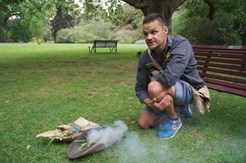Guide Ben Church squats down in Melbourne’s lavish Royal Botanic Gardens (RBG) to perform a ceremony to welcome visitors to the gardens and to the lands of the Bunurong people, its traditional custodians.
The gardens were established in 1846 and display more than 10,000 plant species from around the globe on 38 hectares, making this among the best botanic gardens in the world. The RBG also has an extensive collection of native Australian flora, which Church uses to take visitors far back in time, to long before European contact.
The aim of Church – aboriginal on his mother’s side – is to conjure up the culture of those who were not merely looking at the flora, but utilizing it for shelter, food, tools, clothes and art, and in ceremonies that helped define the roles of individuals in aboriginal society, and the relationships between different groups.
His welcome is in the form of a traditional smoking ceremony, and he kneels to produce a collection of leaves from a kangaroo-skin bag to burn on a small portable wooden hearth, called a coolamon, made from the trunk of one of Australia’s ubiquitous eucalypti, the red gum. With the addition of a strap, its smooth curved surface let it double as a carrying device for assorted items, including babies.
Silver wattle, cherry ballart and eucalyptus leaves each represent a different generation of Bunurong. Their mingled smoke, rising in a thin column between the garden’s towering trees, symbolizes the unity of the tribe.
The ceremony would have been used to grant his own people permission to enter Bunurong territory to share in its resources, acknowledged by visitors placing leaves of their own on the fire, which we do.
The 75-minute walk around the gardens that follows is an introduction to the aboriginal world view. To Church it’s a landscape of seasonal uses and purposes – part larder, part do-it-yourself superstore and part pharmacy – and his descriptions bring aboriginal culture vividly to life.
The silver wattle, with its pretty yellow blossom, has seeds that were ground up and mixed with water to make a dough, then baked into bread. Its bark, warmed in water, was used as a medicine against indigestion. The flexible wood from a young straight sapling was perfect for fishing spears.
The medicinal qualities of eucalypti were known to aboriginals tens of thousands of years before their commercialization overseas, and its wood was perfect for boomerangs and canoes alike. The bush tomato, no actual relation, was both an important seasonal food source, and, when unripe, an oral contraceptive.
A century-old, fat-trunked paperbark tree, its trunk perpetually peeling in soft curls, provided crib liners, roofing for shelters and insulation material. Its flimsy bark, soaked in water, was also used to wrap eels caught with traps woven from the spiny-headed mat rush. When placed in a fire, the parcels steamed them perfectly.
The trip ends back at the hearth in seemingly European style, with a cup of tea. But it’s an aboriginal version, made from the lemon myrtle.
For more information on the Aboriginal Heritage Tour of the Royal Botanical Gardens and to make bookings go to www.rbg.vic.gov.au/whats-on. For information on Melbourne, see www.visitmelbourne.com.
More stories at www.culturelocker.com



